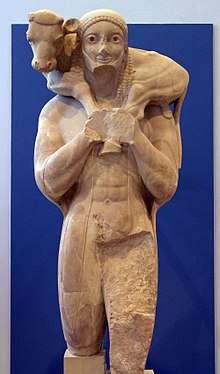Moschophoros
Moschophoros (Greek: μοσχοφόρος "calf-bearer") is an ancient Greek statue of the Archaic period, also known in English as The Calf Bearer. It was excavated in fragments in the Perserschutt in the Acropolis of Athens in 1864. The statue, dated c. 560 BC and estimated to have originally measured 1.65 meters (5.4 ft) in height, is now in the Acropolis Museum in Athens, Greece.

Condition
The condition of the Moschophoros is poor and broken in some areas. The legs are missing below the knees on both sides. The hands are broken off. The genitals and the left thigh have separated from the whole sculpture. The lower half of the face (the chin area) is chipped off. The foot with a plinth is connected to base. The calf is well preserved, while Moschophoros's eyes are absent. The rest of the sculpture is in a fine state.[1]
History
The sculpture was found on the Athenian Acropolis in 1864. In 1887, the base was discovered. It is made of permeable limestone, and its plinth was attached to the right foot of the sculpture.[1]
The inscription on that plinth claims that this statue was dedicated by someone named Rhombos (possibly Kombos or Bombos; the beginning of the name is missing) to Athena, the goddess of wisdom. This suggests that the sponsor was a very well-to-do-man and a prominent citizen of Attica who offered his own likeness to Athena. He has a calf on his shoulders which represents the sacrificial offering he is about to give to the goddess.[2]
Form and relevance
The Moschophoros stands with his left foot a little forward, like other kouroi. He has a thick beard, a symbol of adulthood. He wears a thin cloak. The sculpture's nudity is the main aspect of the art as it adhered to the artistic conventions of the era. The cloak on the other hand, depicts him as a respectable and well-recognized citizen.[3]
The challenge of representing man and animal together is successfully accomplished by this Archaic sculpture. The calf's legs are held firmly, making a bold X-shaped composition. This interaction between the calf and the calf-bearer represents a strong, inseparable bond between the two. The man in the sculpture is smiling, which is a unique and new feature that started from around this time in the art than from earlier Greek statues (and those from Egypt and the Near East).[3]
Kriophoros statues, of a man with a sheep on his shoulders in a similar manner, are more common.
Style
Moschophoros's hair is very curly, encircling his forehead. There are three plaits on each side falling over his chest. The hair at the top is tied with a narrow ribbon. He has a thick beard that curves around his shaved upper and lower lip. The eyes are large and were made out of colored stones. The stones are absent now but it gave a more lively appeal to the statue before. His mouth is very diligently carved and outlined.
By looking at its form and style, this sculpture is typical in its composition of the early 6th century B.C., around 570 B.C.[2]
Interpretation
The main idea of a connection between a man and an animal is strongly portrayed. The crossed legs of the calf with the arms of the calf-bearer creates unity between them. The forms are simple such as the round face, eyes and mouth are created with simple arcs. The beard represents an adult man. The body structure is well built depicting strength and power. His mouth and eyes are round in form giving the impression of a positive person, especially, as the man wears a smile on his face.[1]
See also
- Kriophoros — "ram-bearer".
- Acropolis of Athens
- Kritios boy
References
- "Athens, Acropolis 624 (Sculpture)". www.perseus.tufts.edu. Retrieved 2017-12-01.
- "The Acropolis Museum, The Calf-Bearer, Kritios Boy". madeinatlantis.com. Archived from the original on 27 September 2007. Retrieved 13 April 2018.
- Kleiner, Fred S. (2012). Gardner's Art through the Ages: Backpack Edition, Book 1. Cengage Learning. p. 112. ISBN 9780840030542.
External links
